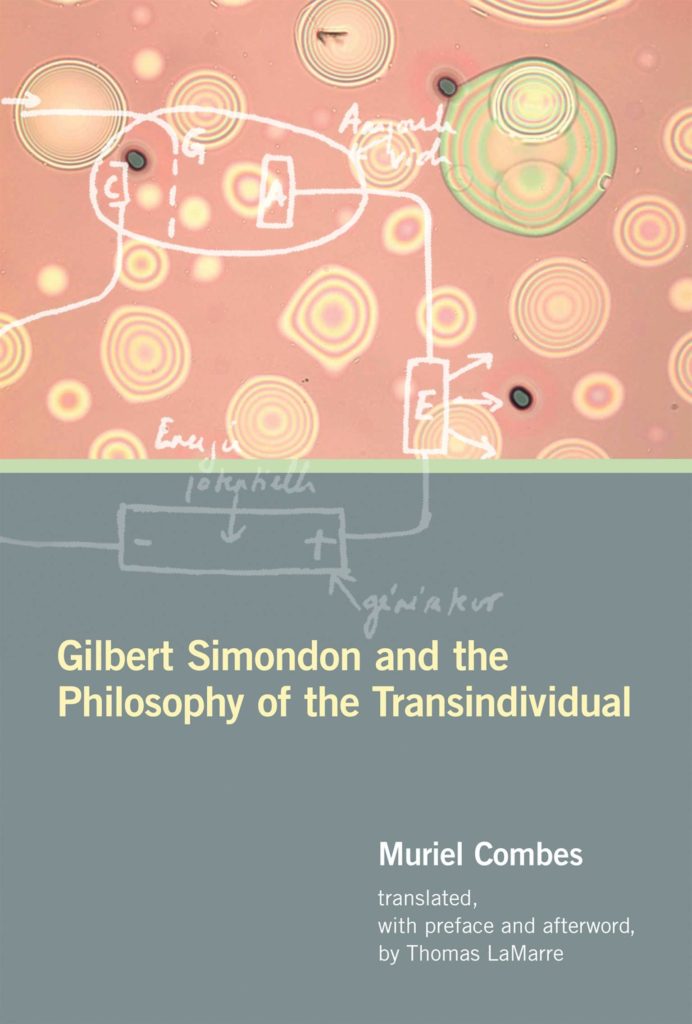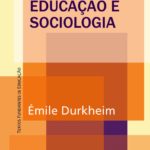
Combes in english, by Thomas LaMarre (2013)
PREFÁCIO
LAMARRE, Thomas. 2013. Preface. In: Muriel Combes. Gilbert Simondon and the Philosophy of the Transindividual. (Trad. Thomas LaMarre) Cambridge: The MIT Press, pp. xiii-xviii.
PONTO-E-VÍRGULA EM SIMONDON E COMBES (movimento do pensamento: “what it means to write processually”)
[I]n her note on Simondon’s style in chapter 1, Combes remarks that, because the French language does not afford conjugations like the gerund -ing that in English may serve to foreground processes, as in, for example, what is happening, Simondon has to invent a style: “For all its subtlety, this style is nonetheless tangible, relying in large part on a specific usage of punctuation: it is thus not rare to see deployed, in a phrase composed of brief propositions connected with semicolons, all the phases of a movement of being or of an emotion.” The same is true of Combes’s style (LaMarre 2013:xv)
PENSAMENTO PROCESSUAL E FUNDACIONAL (atravésXa partir)
“From a lexical point of view, this opposition between à travers (“through” or “by way of”) and à partir de (“from” or “on the basis of”) expresses the great distance separating processual thought from foundational thought.”(Muriel Combes, in: LaMarre 2013:)
DESEMPENHANDO O TRANSINDIVIDUAL NO TRABALHO DE TRADUÇÃO
[M]y translation of Cobes-Simondon strives to enact a transductive relation called the transindividual.” (LaMarre 2013:xviii)
PÓSFÁCIO
LAMARRE, Thomas. 2013. Afterword: Humans and machines. In: Muriel Combes. Gilbert Simondon and the Philosophy of the Transindividual. (Trad. Thomas LaMarre) Cambridge: The MIT Press, pp. 79-108.
ONTOGÊNESE (para além do dualismo e do substancialismo)
[For Simondon] humans and machines are different; they can even be said to be ontologically different, but within an ontology that methodologically avoids dualism and substantialism, which is indeed more precisely called ontogenesis. (LaMarre 2013:80)
ENGENHEIROS CONFIAM NA TECNICIDADE
Perhaps because of his training in sciences and engineering, Simondon confidently speaks of an inherent value to technics, which he calls “technicity”. (LaMarre 2013:81)
METABOLISMO HUMANO-MÁQUINA
As a first step, we might note that, when Simondon says that humans’role or function is to be between machines, he means this biologically. (LaMarre 2013:82)
DETERMINISMO ENERGÉTICO CONTRA O SUBSTANCIALISMO, A DIALÉTICA, A CIBERNÉTICA E O HILEMORFISMO
In other words, his [Simondon’s] approach is not that of material determinism (whether that of genes or atoms, or certain manners of dialectical thinking). Instead, in keeping with the fact that neither genes nor atoms are foundational in contemporary sciences, Simondon`s approach eschews material determinism, looking to what might be called “energetic determinations,” or more precisely, in the language of physics that he adepts, dephasings or phase shifts. That Simondon occasionally glosses dephasing as “doubling” (dédoubler) indicates that he is not intent on dispensing with contrasts or conflicts. Rather, it is a matter of not beginning (and thus ending) with an ontological dualism, with a scission between spirit and substance (substantialism), between human and nature (dialectics), between huan and machine (cybernetics), or between form and matter (hylomorphism). (LaMarre 2013:83)
SIMONDON QUER ENCARAR O INDIVÍDUO A PARTIR DE SUA INDIVIDUAÇÃO
Yet Simondon`s turn to energetics is not intended simply to dissolve those entities that appear concrete to us into a play of forces or field of energies On the contrary, in attending to the underlying energetics of concrete entities in an abstract fashion, Simondon wishes to figure out what gives consistency to specific kinds of “individuals.” Thus, when Simondon looks at an individual from the point of view of its individuation – that is, its dephasing, its underlying energetics – his goal is not to dissolve the concrete individual into abstract forces or to hold the individual under erasure. Instead, he aims at a systematic account of how an individual can enter into relations with other individuals. (LaMarre 2013:83)
FILOSOFIA DA INDIVIDUAÇÃO-RELAÇÃO
If Simondon’s philosophy is aptly characterized as a “philosophy of individuation” as well as a “philosophy of relations,” it is because his focus on the individuation of the individuals in different domains necessarily entails giving real priority to the relation over the terms of the relation. (LaMarre 2013:84)
ESTABILIDADE e INDIVIDUAÇÃO
Simondon reminds us that, if something appears stable to us, that stability is relative to a frame of reference, or more precisely, to a concern. And that frame of reference appears stable because, as a concern, it is also individuating, that is, it is operatively producing a connection between different orders of magnitude. (LaMarre 2013:84)
4 PARÂMETROS (1-germe; 2-solução supersaturada; 3-cristal; 4-meio resultante)
In referring us to metastability and dephasing instead of positing a form-matter distinction, Simondon moves beyond a dualist mode, introducing a series of parameters into his account of form, structure, or individual. There are, in effect, four parameters: (1) the seed or germ that sets off crystallization; (2) the supersaturated solution before crystallization; (3) the crystal; and (4) the less saturated aqueous solution after crystallization. (LaMarre 2013:85)
He [Simondon] explores the underlying processes that generate individuals in terms of the four parameters presented above: (1) [germe?]remarkable points, that is, form or structure of the individual; (2) [solução supersaturada, ok] the charged ground or potentialized associated milieu of the individual that is at once external contrast and internal spacing; (3) [cristal?] the neutral point of the event (absolute origin) of individuation that simultaneously wets off individuation and arises in it; and (4) [meio resultante? Estranho…] the field of preindividual being, which is the specific activation associated with a specific neutral point, that is, the specific activation of a relation between disparate orders of magnitude that “potentializes” or “energizes” the process of individuation. (LaMarre 2013:88)
ANALOGIA ASSUMIDAMENTE FORÇADA (mas interessante) ENTRE SIMONDON e EINSTEIN
Let me force the analogy and say that the absolute origin is eventful like the speed of light within the general theory of relativity. There is a universe of general relativity, but relations are relative to the speed of light in that universe. Likewise, the event of crystallization entails the activation of an individuating “world” or “universe” whose relations are relative to an absolute origin. (LaMarre 2013:86)
O GERME e a DISPARAÇÃO
The neutral point, that little germ of germination, activates a field of potential energy, which is what Simondon calls preindividual being. An individual always implies a part or share of preindividual being, a field of potentiality. But, if we tried to trace back from this field to the neutral point, the neutral point would always appear to be missing as a given point. It is rather like tracing back the movement of galaxies away from the big bang: although it seems that you might be able to trace movement back to a point, you arrive at something where space and time relations cannot be so nicely sorted out. In this respect, Simondon’s disparation appears close to the Deleuzian notion of the plane of immanence or the plane of consistency. (LaMarre 2013:86)
A POLÍTICA RETICULAR DE SIMONDON
[T]o call attention to remarkable points is not a neutral gesture but an analogically consructive cut or an operative fold in reality. In effect, the ground for Simondon’s politics becomes clearer here: he refutes the realism that takes structure or form the be reality; instead he sticks to the realism of relation in order to show not only that the individual is in process but also that stopping or prolonging that process brings into play a dispositif (to use Foucault’s term), that is, a set of techiques, an “apparatus” or “paradigm,” around which procedures of territorialization, discipline, or control may gather. (LaMarre 2013:87)
MEIO ASSOCIADO (sinergia transversal)
It is the relation between external and internal milieu that matters, and Simondon often refers to it as an associated milieu. The associated milieu is what runs across the structure’s contrast (external milieu) and spacing (internal milieu). It is thus the ground of the ground, the true ground, as it were. […] In sum, the associated milieu is the energetically charged field running across internal spacing and external contrast. (LaMarre 2013:88)
Simondon offers a range of examples of the reciprocal or recurrent relations of causality that arise between the technical object and its external milieu, but as with the crystal, what is crucial is the associated milieu that both links and grounds this link between internal and external milieus. (LaMarre 2013:)
INDIVIDUAÇÃO contra MODERNIZAÇÃO/DISCIPLINARIZAÇÃO
Simondon turns to individuation as process in order to address what he sees as another dangerous tendency of modern knowledge: the isolation of disciplines from one another on the basis of their construction of different individuals (society, psyche, medium, organism, species, machine) that are not allowed to communicate with one another whose relationality becomes unthinkable. […] This is why Simondon works so intently within and across different domains of knowledge: he aims for a truly concerned multidisciplinarity. (LaMarre 2013:89)
OBJETO NATURAL-TÉCNICO
Simondon replaces the distinction between organism and mechanism with a distinction between natural object and technical object, surely because the former terms have been inextricably entwined with dualist thought to the point where they tend to imply a substantialist distinction between nature and artifice, nature and culture, or nature and humans. And so, in styling both organisms and mechanisms as “objects,” he reminds us that these beings or modes of existence are ontologically different in degree (analogous), not ontologically different in kind or nature (substantially). (LaMarre 2013:90)
SUJEITO e OBJETO como PERSPECTIVAS
[S]ubject and object are different points of view across the same reality, that is, on the same relation. (LaMarre 2013:90)
Simondon does not see the passage fro one mode of existence to another – say, from physical being to natural or vital being – in terms of a linear advance. Rather, developments that appear to come after or to be added to prior stages actually entail a return to what is ontologically prior, through a reimmersion in the preindividual. Just as an animal starts as an inchoate plant, so a natural [living] individual begins as an inchoate physical individual. (LaMarre 2013:90)
TECNOPOLÍTICA SIMONDONIANA
[Simondon] sees in the tendency to collapse or conflate distinctions between natural objects and technical objects, not merely a metaphysical error but a form of moral panic as ell, which ultimately serves to depoliticize the technical existence of humans. Near the end of the first part of Du mode d’existence des objets techniques, he strives to clarify the stakes historically and politically: as, in modern times, humans have constructed machines that can bear tools and thus replace them as technical individuals or tool bearers, humans have tended wrongly to apply ideas of slavery and freedom to this new relation (MEOT, 82). Such a mistake is not purely or simply psychological in origin. It derives from actual conditions in which humans now tend to work over or under machines, rather than alongside them. Yet, when humans look at their relationship to machines in terms of slavery and freedom, they merely repeat these conditions, striving either to liberate themselves from machines or to enslave the machines once and for all. Needless to say, the fear of a robot revolution grows as a result. Simondon`s comments suggest that thinking in (largely juridical) terms of human freedom from, or mastery over, machines constitutes a genuine blockage for progressive politics. (LaMarre 2013:91)
INVENÇÃO-CONCRETIZAÇÃO
When he looks at the individuation of machines from the angle of the process of invention, Simondon sees a passage from an abstract, analytical, logical system toward a concrete, synthetic, practical system. Inventors begin designing machines with an eye to accomplishing a single task, which they diagram in an abstract, analytic fashion; but as they actually use the machine, the design itself begins to demand practical adjustments, bringing into play other aspects of its basic elements, adding new elements, and creating new relations among elements. (LaMarre 2013:92-3)
PROBLEMA COMUM DE INTERPRETAÇÃO DA “MARGEM DE INDETERMINAÇÃO” EM SIMONDON (achar que ela aumenta com a concretização, quando na verdade ela diminui à medida que o objeto técnico se aproxima do natural)
. (LaMarre 2013:93)
SISTEMA INTERNO DE CAUSALIDADES RECÍPROCAS
Simondon characterizes the internam milieu of the machine in terms of recurrent causality. A host of other, apparently synonymous terms also peppers his account, such as “circular causality,” “circularity,” “recursive causality,” “reciprocal relations,” and even “feedback loop.” “Recurrent causality” is by far the favored expression. But what does this term mean? As the technical individual becomes more concrete, synthetic, and practical, its internal ground, the spacing between elements, ceases to be empty space; it eases to rely on purely logical relations. The inventor begins to see that elements can be used with more than one function, for instance, thus tightening up the relations between elements as well as producing the possibility for internal circularity, feedback, reciprocity, or recurrence, and thus, ultimately, for self-regulation. (LaMarre 2013:93)
WHAT I INVENT is THINKING TOO
[I]t is clear that the inventor and invention are thinking with one another, and this thinking, insofar as it is a relation, is on both sides, and it is entirely real. (LaMarre 2013:93-4)
SIMONDON e STENGERS-LATOUR (relações controversas!)
. (LaMarre 2013:95)
[B]ecause Simondon insistently specifies and qualifies what counts as a technical individual, his account shows greater concern for speaking with machines (or with technicity) rather than speaking for them (Latour’s emphasis on representation) or about them (Stengers’s focus on science’s politics of truth). (LaMarre 2013:96-7)
OBJETO TÉCNICO-VIVO
The ground of technical individual shows recurrent causality, both internally and externally. But these two sites of recurrent causality are not symmetrical or identical. As such, the internal ground and external ground have to “communicate more actively across their asymmetry, and have to stabilize that communication. The result is a self-regulating individual, closer to a natural [living] object than a physical object. But how are we to relate to this self-regulating individual? (LaMarre 2013:97)
OS HUMANOS PRECISAM SE RELACIONAR INVENTIVAMENTE COM A CONCRETIZAÇÃO TÉCNICA DE SUA RELAÇÃO COM O MUNDO
[W]hat is human in machines cannot be seized consciously or rationally in the sense of pure reason or cognition. In effect, how machines are “used” (or rather, participated in) should follow from how machines are invented. It is precisely because invention proceeds in a hands-on, practical, and inventive fashion, as a sort of dialogue between humans and machines that engages the preindividual within humans, that humans should not strive to “use” machines in a purely rational, utilitarian fashion. Rather that relation to machines needs to sustain a practical inventive engagement with what is human in machines – in a word, technicity. (LaMarre 2013:98)
SABER-PODER em SIMONDON (Foucault)
[L]ike Foucault, Simondon sees knowledge as operative, as inseparable from power, and in this respect his critique of substantialism and hylomorphism, for instance, is not intended as a purely logical intervention, and his insistence on analogy is, in fact, an attempt to provide a knowledge whose operativity is adequate to the resistance implicated within the activation of fields around technical individuals. (LaMarre 2013:99)
TECNICIDADE x ECONOMIA
It is technicity that makes technical individuals the most important site for neutralizing and countering the subordination of all fields of rationality to economic concerns in the modern era. (LaMarre 2013:99)
SIMONDON e INFOCAPITALISMO (Negri)
Drawing on Antonio Negri and postoperaism in a truly prescient manner, Combes also shows how Simondon’s account provides a rich source of counterknowledge for the post-Fordist era of information society in which knowledge has been built back into labor and production, making explicit that a factory was never just a production formation but always also a power-knowledge formation. (LaMarre 2013:99)
TECNICIDADE e o HUMANISMO SIMONDONIANO
In effect, the neutral point of the technical individual is the human, whose absolute origin or eventfulness is technicity. Here we come face to face with Simondon`s humanism, that is, the centrality of the human being in his philosophy. (LaMarre 2013:100)
A PERSPECTIVA DA INDIVIDUAÇÃO
To look at a mode of existence in terms of its individuation is to look at it from the angle of the underlying and surrounding processes that are part of its genesis, making it what it is. (LaMarre 2013:100)
OBJETO VIVO=TÉCNICO (causalidade interna)
[T]he technical individual is a particular kind of technical object (a specific mode of technical existence). In the course of its individuation (concrescence), the technical individual generates zones of recurrent causality, both internally and externally, which are the charged transversal ground (associated milieu) for its efficient structuration of remarkable points. For Simondon such developments bring the technical object closer to the natural [living] object. The natural object also entails both an internal energetic “recurrent causality” between its elements and an external energetic “recurrent causality” with its surroundings that constructs an associated milieu. In his account of the technical individual approaching the natural object, Simondon not only begins with the internal causality of the machine but also repeatedly defends this point of departure. (LaMarre 2013:100-1)
The focus on internal adaptations allows Simondon to avoid the model of a machine statically adapted to an environment, which then finds itself stranded and at a loss when the environment changes. Instead, like the natural object (organism), the technical individual effects internal changes and simultaneously generates a recurrent rapport with its external milieu, which allows it to interact actively with the world and to produce a transformative series. (LaMarre 2013:101)
CRÍTICA AO DARWINISMO SOCIO-ECONÔMICO
. (LaMarre 2013:102)
A SACADA (strange twist!) SIMONDONIANA DA RELAÇÃO HUMANO-MÁQUINA: a gênese do indivíduo técnico precisa mudar a relação do humano com o objeto técnico
[P]rior to modern machines, humans were the tool-bearers, playing the role of technical individuals. With the advent of technical individuals that bear tools, humans find themselves situated either below or above the machine. They become either caretakers of the machine or supervisors of ensembles of machines, a contrast reminiscent of that between worker and foreman or capitalist in Marx. For Simondon, such a genealogy is also remarkably close to the cyborg or cybernetic understanding of technicity, in which humans oscillate between enslaving machines and being enslaved by them. Not surprisingly, then, Simondon introduces a strange twist in this initially straightforward history: n fact, the role of tool-bearer, or of technical individual, does not rightly belong to humans. It is as if they had preemptively seized it from machines but had forgotten and come to mistake toolbearing as their function. In other words, while Simondon proposes a break with the industrial factory system that effectively makes humans into workers under, or supervisors over, machines, he is not interested in a return to a premodern guild or artisan formation in which the role of humans was closer to the technical individual. In effect, he is proposing that humans dig deeper into their evolutionary sources, to seek something prior to the technical being and human being that traverses them. (LaMarre 2013:102-3)
NEOTENIA e PLURIPOTÊNCIA PRÉINDIVIDUAL
[N]eoteny is one way to grasp concretely the role of pluripotentiality or preindividual being in the context of evolutionary development. (LaMarre 2013:104)
NORMATIVIDADE SIMONDONIANA (ter-que-devir)
As Combes points out, that terms such as “should” and “true” arise in Simondon presents a certain risk, as does his use of reason, universality, and progress: we must be careful not to read such terms in an entirely normative fashion, as if Simondon were saying, “Because reality is this way, you have to align yourself with it.” Simply put, if you’re not becoming, you’re wrong. Like Combes, I feel that such a normative reading of Simondon ultimately is not justified by his project as a whole, but it is crucial to signal such a risk, because other commentators have opted for the normative reading: having-to-become. (LaMarre 2013:106)
MINORITÁRIO em SIMONDON (D&G)
[A]s with Deleuze and Guattari’s notion of the minor, Simondon strives to trace out countertendencies (and potentially counteractualizations) to the “major” tendency in which technological evolution has been mapped onto human evolution, making linear progress appear natural, reasonable, and inevitable. In effect, like Deleuze and Guattari, Simondon’s politics of technology tends to become localized around a becoming-minor within the majority, though in the specific instance of modern technical ensembles. (LaMarre 2013:108-7)
DEVIR MINORITÁRIO DA NEOTENIA HUMANA em sua RELAÇÃO COM O OBJETO TÉCNICO
In any event, humans’ becoming-minor vis-à-vis technical individuals in Simondon hinges on a kind of neoteny of the human being, in which humans “return” to a moment that might be described as historically prior to their usurpation of the role of technical individual, to a more juvenile relation to technology that entails a genuine reckoning with technical elements as technical values that are autonomous of other concerns, such as economic value. With this “rediscovery” of the essence of technicity, humans will no longer strive to play the role of technical individual, or to play the role of servant or master to machines. The new role for humans might be described as technician, physician, or diplomat vis-à-vis machines, which implies the discovery of new kinds of technical ensembles for working with machines, closer to laboratories, hospitals, and embassies than to factories. (LaMarre 2013:107)





 LaSPA is located at the Institute of Philosophy and Human Sciences (
LaSPA is located at the Institute of Philosophy and Human Sciences (